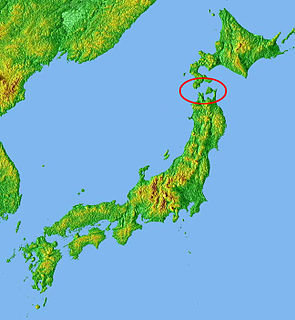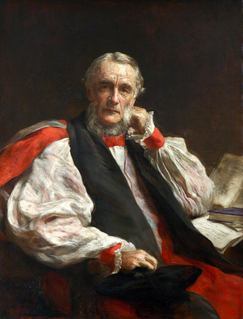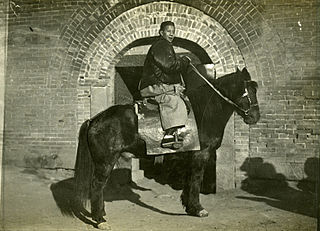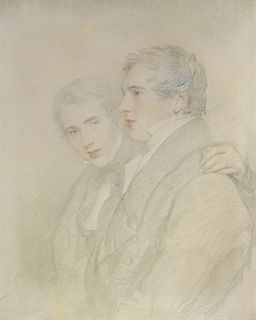
The Tsugaru Strait is a strait between Honshu and Hokkaido in northern Japan connecting the Sea of Japan with the Pacific Ocean. It was named after the western part of Aomori Prefecture. The Seikan Tunnel passes under it at its narrowest point 12.1 miles (19.5 km) between Tappi Misaki on the Tsugaru Peninsula in Aomori Prefecture, Honshu, and Shirakami Misaki on the Matsumae Peninsula in Hokkaido.

John Latham was an English physician, naturalist and author. His main works were A General Synopsis of Birds (1781–1801) and General History of Birds (1821–1828). He was able to examine specimens of Australian birds which reached England in the last twenty years of the 18th century, and was responsible for providing English names for many of them. He named some of Australia's most famous birds, including the emu, sulphur-crested cockatoo, wedge-tailed eagle, superb lyrebird, Australian magpie, magpie-lark and pheasant coucal. He was also the first to describe the hyacinth macaw. Latham has been called the "grandfather" of Australian ornithology.

Thomas Littleton Powys, 4th Baron Lilford, was a British aristocrat and ornithologist.

Blakiston's fish owl, the largest living species of owl, is a fish owl, a sub-group of eagle-owls which specialize in hunting in riparian areas. It is native to China, Japan, and the Russian Far East. This species is a part of the family known as typical owls (Strigidae), which contains most species of owl. Blakiston's fish owl and three related species were previously placed in the genus Ketupa; however, mtDNA cytochrome b sequence data is equivocal on which of the two genus names is more appropriately applied for this species. Its habitat is riparian forest with large, old trees for nest sites that is near lakes, rivers, springs, and shoals that do not freeze in winter. Henry Seebohm named this bird after the English naturalist Thomas Blakiston, who collected the original specimen in Hakodate on Hokkaidō, Japan in 1883.
Sir James Wallace was an officer of the Royal Navy. He served for a time as a colonial governor.

Elinor Mary Darwin was an Irish born illustrator, engraver and portrait painter. Her illustrations were included in several of her husband, Bernard Darwin's books for children.

Charles Wright was an American botanist.
Henry Brougham Guppy was a British surgeon, geologist, botanist and photographer. He was awarded the Linnean Medal in 1917.
John Mottrom, or Mottram, was one of the first, if not the first, white settlers in the Northern Neck region of Virginia between 1635 and 1640.

Edward Henry Bickersteth was a bishop in the Church of England and he held the office of Bishop of Exeter between 1885 and 1900.

Edwin Dun was a rancher from Ohio who was employed as an o-yatoi gaikokujin in Hokkaidō by the Hokkaidō Development Commission (Kaitakushi) and advised the Japanese government on modernizing agricultural techniques during the Meiji modernization period.

Rear-Admiral Richard Charles Mayne was a Royal Navy officer and explorer, who in later life became a Conservative politician.

Arthur de Carle Sowerby was a British naturalist, explorer, writer, and publisher in China. His father was Arthur Sowerby.

Andrew Bloxam was an English clergyman and naturalist; in his later life he had a particular interest in botany. He was the naturalist on board HMS Blonde during its voyage around South America and the Pacific in 1824–26, where he collected mainly birds. Later as a Church of England minister he lived in Warwickshire and Leicestershire and made significant contributions to the study of the natural history of the area. His special interest was in fungi and the genera Rubus and Rosa. His botanical author abbreviation is "A.Bloxam".

William West, FLS was an English pharmacist, botanist, microscopist and writer, particularly noted for his studies of freshwater algae. His sons, both botanists, were William West Jr with whom he did fieldwork, and George Stephen West with whom West co-wrote botanical publications for more than 20 years.

Philip Herbert Carpenter, FRS, British naturalist and crinoid authority, was the fourth son of William Benjamin Carpenter.
William Gosse was a medical practitioner in the early days of South Australia.

Thomas George Bond Howes, FRS was an English zoologist.

Thomas Drury Smeaton trained in England as an engineer, emigrated to the British colony of South Australia, where he was known as a banker and amateur scientist.

The Blakiston Line or Blakiston's Line is a faunal boundary line drawn between two of the four largest islands of Japan: Hokkaidō in the north and Honshū, south of it. It can be compared with faunal boundary lines like the Wallace Line. Certain animal species can only be found north of Blakiston's Line, while certain other species can only be found south of it.















